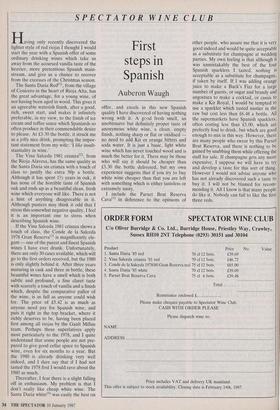SPECTATOR WINE CLUB
Having only recently discovered the lighter style of red riojas I thought I would start the year with a Spanish offer of some ordinary drinking wines which take us away from the accursed vanilla taste of the heavier, more pretentious Spanish main- stream, and give us a chance to recover from the excesses of the Christmas season.
The Santa Darla Red(1), from the village of Cenicero in the heart of Rioja Alta, has the great advantage, for a young wine, of not having been aged in wood. This gives it an agreeable waterish finish, after a good, rich, sweet start, and makes it infinitely preferable, in my view, to the finish of ice cream and toffee sauce which Spaniards so often produce in their commendable desire to please. At £3.30 the bottle, it struck me as a jolly nice drink, prompting the impor- tant statement from my wife: 'I like insub- stantiality in wine.' The Vina Salceda 1981 crianza(2), from the Rioja Alavesa, has the same quality as the Santa Dania sin crianza with a touch of class to justify the extra 50p a bottle. Although it has spent 11/2 years in oak, it has none of the horrible taste of Spanish oak and ends up as a beautiful clean, fresh wine which everyone will like. There is not a hint of anything disagreeable in it. Although punters may think it odd that I stress this somewhat negative quality, I feel it is an important one to stress when describing Spanish wine.
If the Vina Salceda 1981 crianza shows a touch of class, the Conde de la Salceda 1978 Gran Reserva(3) is magnificently ele- gant — one of the purest and finest Spanish wines I have ever drunk. Unfortunately, there are only 30 cases available, which will go to the first orders received, but the 1980 is only slightly behind it. After three years maturing in cask and three in bottle, these beautiful wines have a smell which is both subtle and profound, a fine claret taste with scarcely a touch of vanilla and a finish which, despite the comparative pallor of the wine, is as full as anyone could wish for. The price of £5.42 is as much as anyone need pay for Spanish wine, and puts it right in the top bracket, where it richly deserves to be, having been placed first among all riojas by the Gault Millau team. Perhaps these superlatives apply most particularly to the 1978, and I quite understand that some people are not pre- pared to give good cellar space to Spanish wine, even for six months to a year. But the 1980 is already drinking very well indeed, and I dare say that if I had not tasted the 1978 first I would rave about the 1980 as- much.
Thereafter, I fear there is a slight falling off in enthusiasm. My problem is that I don't really like cheap white wine. The Santa Dania white(4) was easily the best on
First steps in Spanish
Auberon Waugh
offer, and excels in this new Spanish quality I have discovered of having nothing wrong with it. A good fresh smell, an unobtrusive but definitely proper taste of anonymous white wine, a clean, empty finish, nothing sharp or flat or oxidised — no need to add Kir or orange bitters and soda water. It is just a basic, light white wine which has never touched wood and is much the better for it. There may be those who will say it should be cheaper than £3.30 the bottle delivered, but my own experience suggests that if you try to buy white wine cheaper than that you are left with something which is either tasteless or extremely nasty.
I include the Parxet Brut Reserva Cava(5) in deference to the opinions of other people, who assure me that it is very good indeed and would be quite acceptable as a substitute for champagne at wedding parties. My own feeling is that although it was unmistakably the best of the four Spanish sparklers I tasted, nothing is acceptable as a substitute for champagne, if taken by itself. If I was adding orange juice to make a Buck's Fizz for a large number of guests, or sugar and brandy and angostura to make a cocktail, or cassis to make a Kir Royal, I would be tempted to use a sparkler which tasted nastier in the raw but cost less than £6.48 a bottle. All the supermarkets have Spanish sparklers, often costing less than £5.00, which are prefectly foul to drink, but which are good enough to mix in this way. However, there are many people who swear by this Parxet Brut Reserva, and there is nothing to be gained by snubbing them while offering the stuff for sale. If champagne gets any more expensive, I suppose we will have to try and develop a taste for this sort of thing. However I would not advise anyone who has not already discovered such a taste to buy it. I will not be blamed for recom- mending it. All I know is that many people do like it. Nobody can fail to like the first three reds.










































 Previous page
Previous page